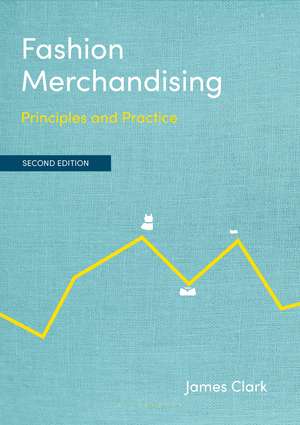Fashion Merchandising: Principles and Practice
Autor James Clarken Limba Engleză Paperback – 15 noi 2020
Preț: 273.89 lei
Preț vechi: 330.98 lei
-17% Nou
Puncte Express: 411
Preț estimativ în valută:
52.42€ • 54.52$ • 43.27£
52.42€ • 54.52$ • 43.27£
Carte tipărită la comandă
Livrare economică 14-28 aprilie
Livrare express 08-14 martie pentru 92.39 lei
Preluare comenzi: 021 569.72.76
Specificații
ISBN-13: 9781352011104
ISBN-10: 1352011107
Pagini: 274
Dimensiuni: 178 x 254 x 22 mm
Greutate: 0.52 kg
Ediția:2nd ed. 2021
Editura: Bloomsbury Publishing
Colecția Bloomsbury Academic
Locul publicării:London, United Kingdom
ISBN-10: 1352011107
Pagini: 274
Dimensiuni: 178 x 254 x 22 mm
Greutate: 0.52 kg
Ediția:2nd ed. 2021
Editura: Bloomsbury Publishing
Colecția Bloomsbury Academic
Locul publicării:London, United Kingdom
Caracteristici
A companion website provides a range of resources for both lecturers and students, including an answer key for exercises, class assignments, lecture slides and additional exercises
Notă biografică
James Clark is a Senior Lecturer and Course Leader at London College of Fashion, UAL specializing in buying, merchandising and supply chain. As a PhD researcher James researches the effects of innovative technology on retail business model design.Prior to joining UAL, James held positions with Debenhams, Coats Viyella and House of Fraser. This experience blended with his academic research interests has enabled James to publish Fashion Merchandising: Principles and Practice.James is a member of research hubs within LCF and SIGs within the academic sector both within the UK and internationally. He is a Fellow of the HEA, holds a Chartered Manager award with the CMI and sits on the Chartered Association of Business Schools Executive Education Committee.
Cuprins
PART I: INTRODUCTION AND CONTEXT OF THE FASHION MERCHANDISER ROLE 1. Fashion Retailing 2. Fashion, Business and Product 3. The activities of Buying and Merchandising 4. Organizing the Buying and Merchandising Function PART II: FASHION MERCHANDISING 5. Fashion Merchandising: The Prentice Day Case Study 6. Fashion Merchandising: Research and Analysis 7. Fashion Merchandising: Budgeting 8. Fashion Merchandising: Open to Buy 9. Fashion Merchandising: Range Planning 10. Fashion Merchandising: Sizing, Deliveries and Allocation PART III: FASHION MERCHANDISING AND THE MODERN TRADING ENVIRONMENT 11. Merchandising: A global perspective 12. e-Commerce and buying and merchandising 13. The merchandiser and the supply chain 14. Sustainability and product management.
Recenzii
The revised and updated second edition of Fashion Merchandising is hugely valuable. The presentation is clear and organised into distinct sections starting by setting merchandising in the wider context of fashion retail and buying, followed by a section examining the role of the fashion merchandiser in detail. There is perhaps no role in the fashion supply chain more impacted by advances in digital technology than fashion merchandising, where access to data analysis and large volumes of information have changed beyond compare, and so it is good to see the final section addresses merchandising in a digital context as well as other contemporary issues such as sustainability and the global industry. The book is an excellent companion to any fashion course, in particular fashion business courses at undergraduate and postgraduate level. A highlight of the text is the good range of relevant case studies, examples and further reading, which will support any taught programme of study in fashion merchandising.
For anyone wanting to understand the role of fashion buying and merchandiser, this book provides insight to the role, environment, and up-to-date case examples. This book will be extremely useful to those study merchandising, and for those operating in fashion business.
The fashion merchandiser's key role in the apparel business is articulated through detailed analysis of the various practices undertaken, and supported by provision of numerous case-studies. Written in an accessible manner that includes suggestions for class-room activities and self-directed study, the updated edition of Fashion Merchandising is a valuable resource for academics and students alike.
For anyone wanting to understand the role of fashion buying and merchandiser, this book provides insight to the role, environment, and up-to-date case examples. This book will be extremely useful to those study merchandising, and for those operating in fashion business.
The fashion merchandiser's key role in the apparel business is articulated through detailed analysis of the various practices undertaken, and supported by provision of numerous case-studies. Written in an accessible manner that includes suggestions for class-room activities and self-directed study, the updated edition of Fashion Merchandising is a valuable resource for academics and students alike.
